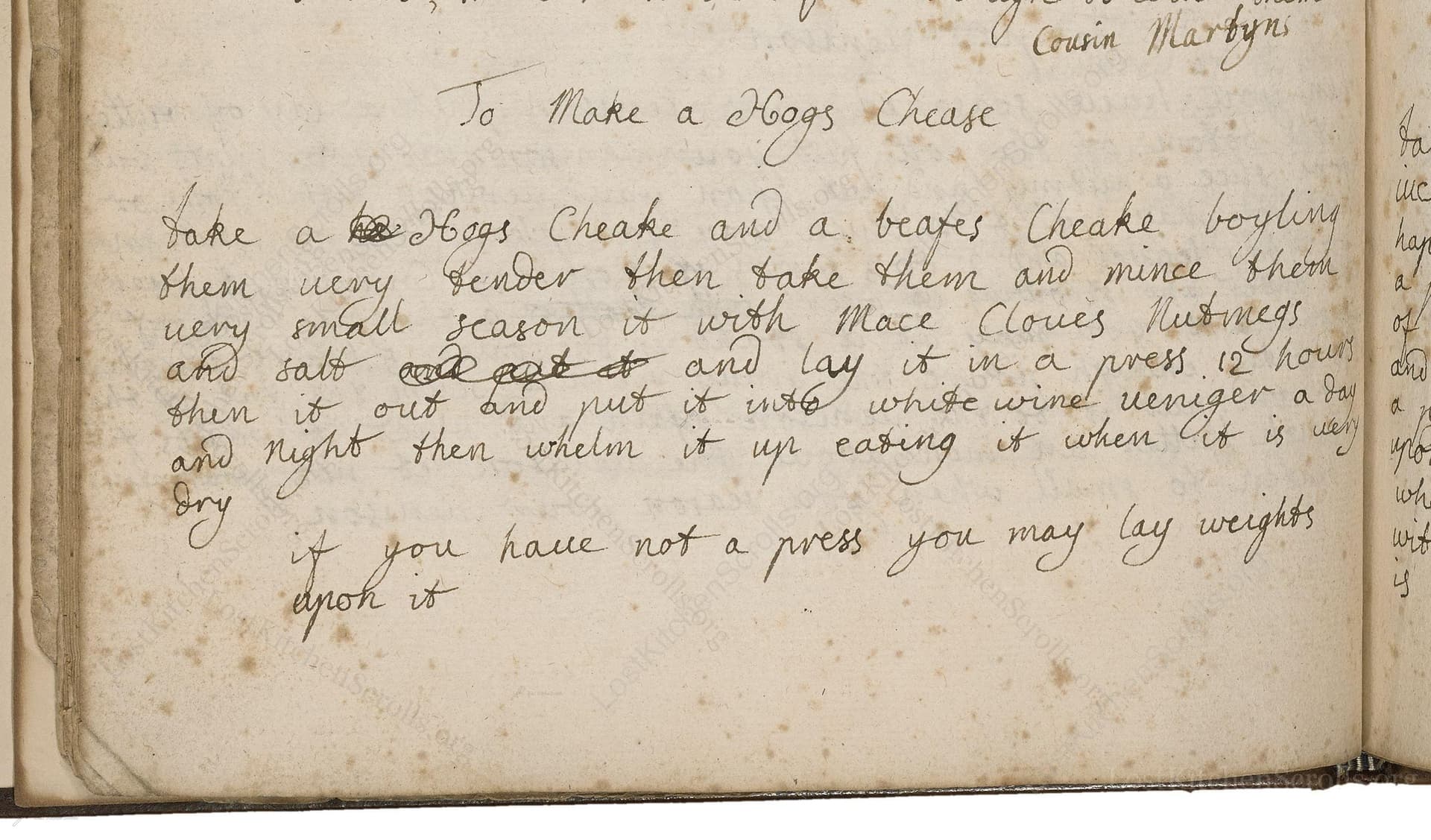To Make A Hoggs Chease
From the treasured pages of Receipt book
Unknown Author

To Make A Hoggs Chease
"Take a Hogs Cheake and a beafes Cheake boyling them very tender then take them and mince them very small season it with Mace Cloves Nutmegs and salt and lay it in a press 12 hours then it out and put it into white wine veniger a day and Night then whelm it up eating it when it is very dry. if you have not a press you may lay weights apon it"
Note on the Original Text
This recipe exemplifies early modern English manuscript cookery, written in conversational prose with limited punctuation and spelling that reflects the dialect of the time (e.g., 'Chease' for 'cheese', actually a pressed meat loaf). Directions are short and assume practical knowledge in the kitchen, omitting precise measures and using context-driven language like 'very tender' for doneness. Spices and processes (like 'whelming up' or pressing) are described briefly, relying on the reader's familiarity with domestic preservation methods.

Title
Receipt book (1700)
You can also click the book image above to peruse the original tome
Writer
Unknown
Era
1700
Publisher
Unknown
Background
A delightful glimpse into the kitchens of the early 18th century, this historic culinary manuscript promises a feast of recipes, remedies, and perhaps a pinch of mystery. Expect both practical fare and elegant inspiration for the curious cook.
Kindly made available by
Folger Shakespeare Library
This recipe hails from around 1700, a time when using every part of the animal was both economical and celebrated. Dishes like this 'Hoggs Chease' represented a form of preserved meat popular before refrigeration, marrying pork and beef cheeks with fragrant spices then pressing and pickling them for storability. Cookbooks and manuscripts from this era often circulated among households, capturing a blend of English household savvy and the luxury of imported spices. White wine vinegar, aromatic cloves, and mace signal a table aiming for refinement as well as thrift.

At the time, cooks would have used large iron pots over open fires or hearths for boiling the cheeks. Mincing would be done laboriously by hand with robust knives or cleavers. The pressing required either a dedicated cheese or meat press, often a wooden device with heavy stones or iron weights. For soaking and storing, stoneware or ceramic dishes would have been used. Serving would involve slicing with a sharp knife, and drying would rely on cool pantries or larders rather than refrigeration.
Prep Time
1 hr
Cook Time
3 hrs
Servings
8
We've done our best to adapt this historical recipe for modern kitchens, but some details may still need refinement. We warmly welcome feedback from fellow cooks and culinary historians — your insights support the entire community!
Ingredients
- 1 pig's cheek (approx. 2.2–3.3 lbs; if unavailable, pork shoulder as substitute)
- 1 beef cheek (approx. 2.2–3.3 lbs; brisket or shin can substitute)
- 1/2 tsp ground mace
- 1/2 tsp ground cloves
- 1 tsp grated nutmeg
- 0.35 oz sea salt
- 3 1/8 cups white wine vinegar
Instructions
- Begin by simmering one pig's cheek (approximately 2.2–3.3 lbs) and one beef cheek (2.2–3.3 lbs) in enough water to cover the meat completely.
- Cook gently until the cheeks are very tender, about 2–3 hours.
- Remove the cheeks, let them cool slightly, and mince them finely.
- Season the minced mixture with 1/2 teaspoon ground mace, 1/2 teaspoon ground cloves, 1 teaspoon freshly grated nutmeg, and 0.35 oz sea salt.
- Pack the seasoned meat tightly into a loaf tin or terrine mold, then press it with a heavy weight (or use a sturdy press) for about 12 hours in the fridge.
- Remove the pressed meat and soak it in enough white wine vinegar to cover, letting it marinate for 24 hours (a day and a night).
- Take the meat out of the vinegar, drain thoroughly, and let it air dry in the fridge until quite firm and almost dry to the touch before slicing and serving.
Estimated Calories
350 per serving
Cooking Estimates
It takes a few hours to cook the meat until tender, plus some time to mince, season, press, soak in vinegar, and dry. The whole process is spread across two days. Each serving contains about 350 calories, and the recipe makes 8 portions.
As noted above, we have made our best effort to translate and adapt this historical recipe for modern kitchens, taking into account ingredients nowadays, cooking techniques, measurements, and so on. However, historical recipes often contain assumptions that require interpretation.
We'd love for anyone to help improve these adaptations. Community contributions are highly welcome. If you have suggestions, corrections, or cooking tips based on your experience with this recipe, please share them below.
Join the Discussion
Rate This Recipe
Dietary Preference
Main Ingredients
Occasions

Den Bockfisch In Einer Fleisch Suppen Zu Kochen
This recipe hails from a German manuscript cookbook compiled in 1696, a time whe...

Die Grieß Nudlen Zumachen
This recipe comes from a rather mysterious manuscript cookbook, penned anonymous...

Ein Boudain
This recipe comes from an anonymous German-language manuscript cookbook from 169...

Ein Gesaltzen Citroni
This recipe, dating from 1696, comes from an extensive anonymous German cookbook...
Browse our complete collection of time-honored recipes



